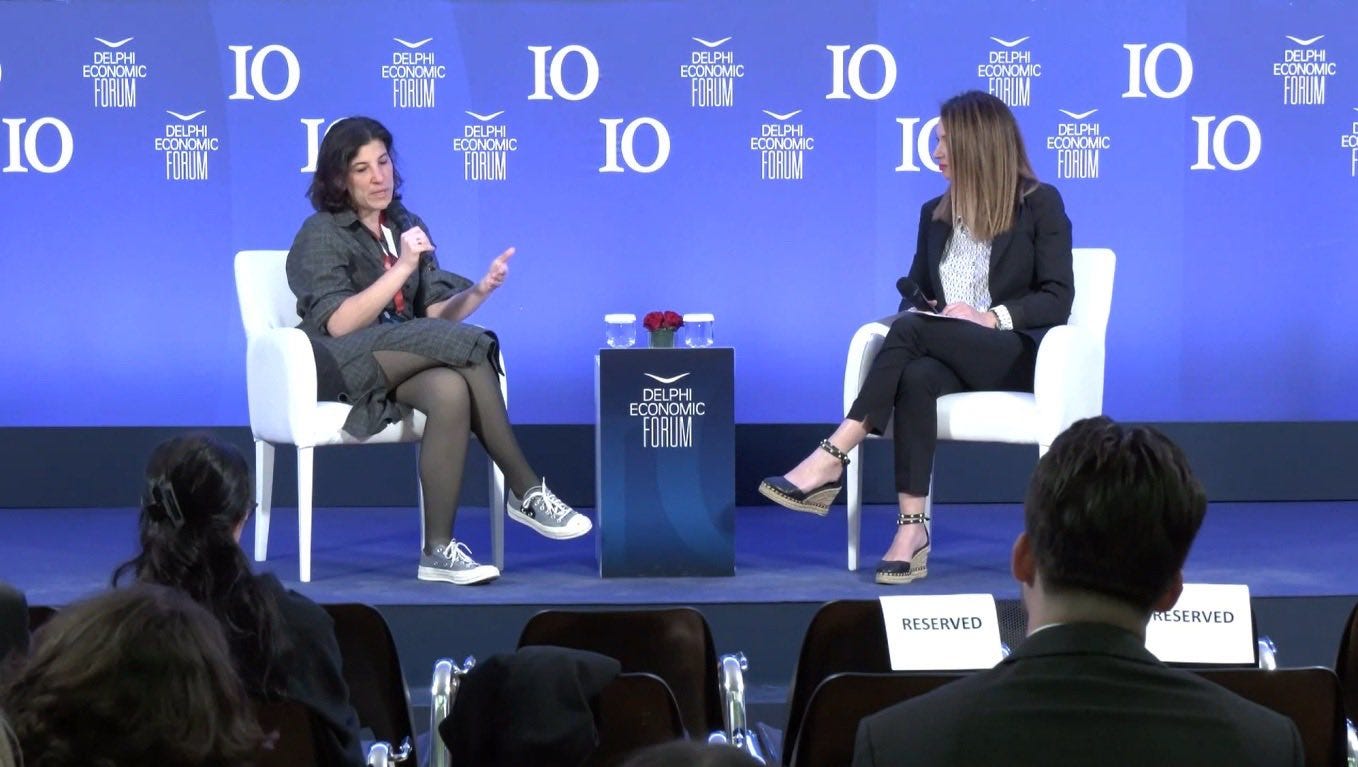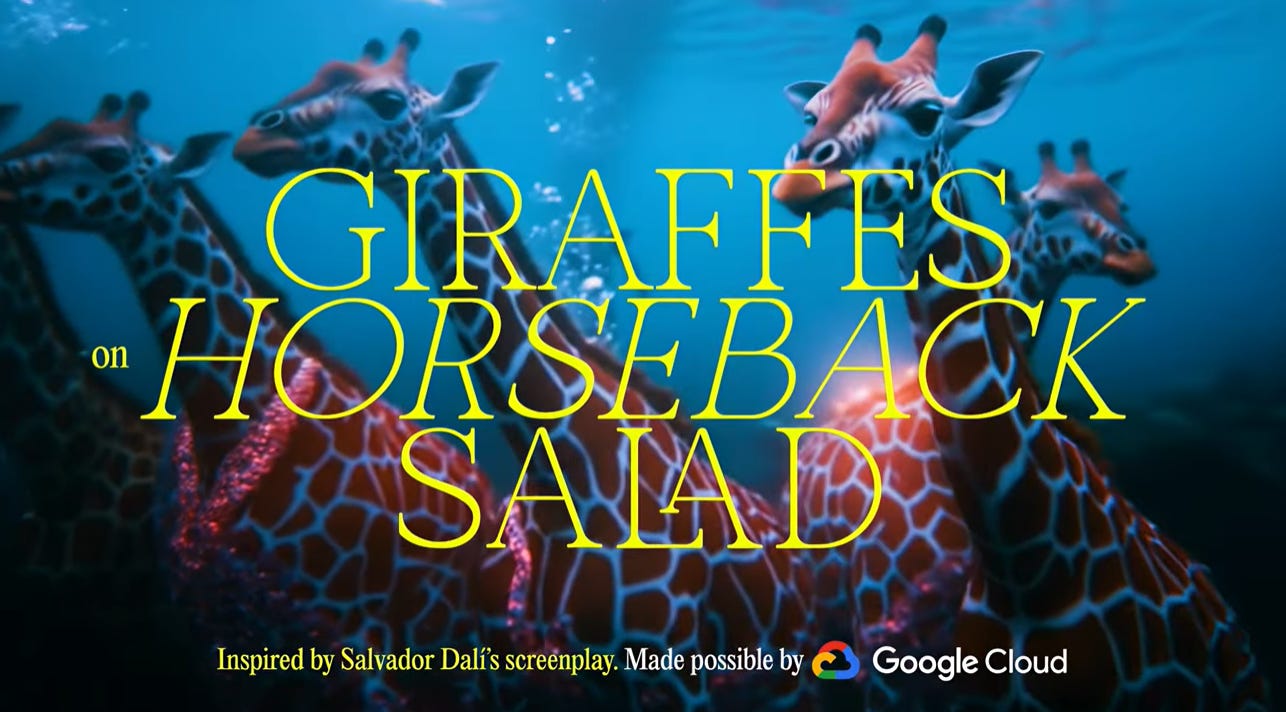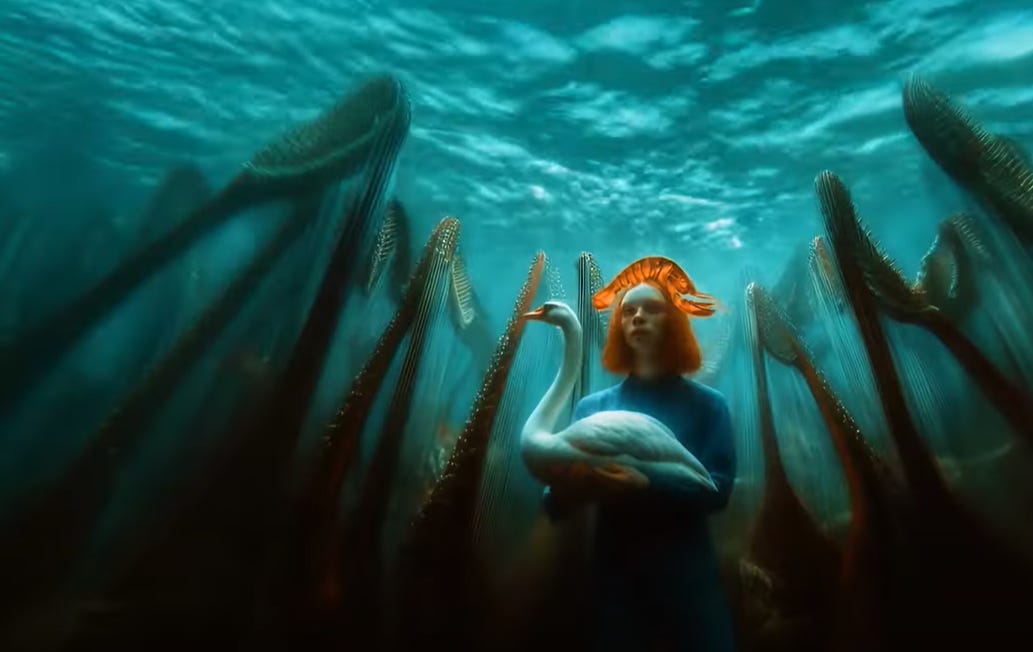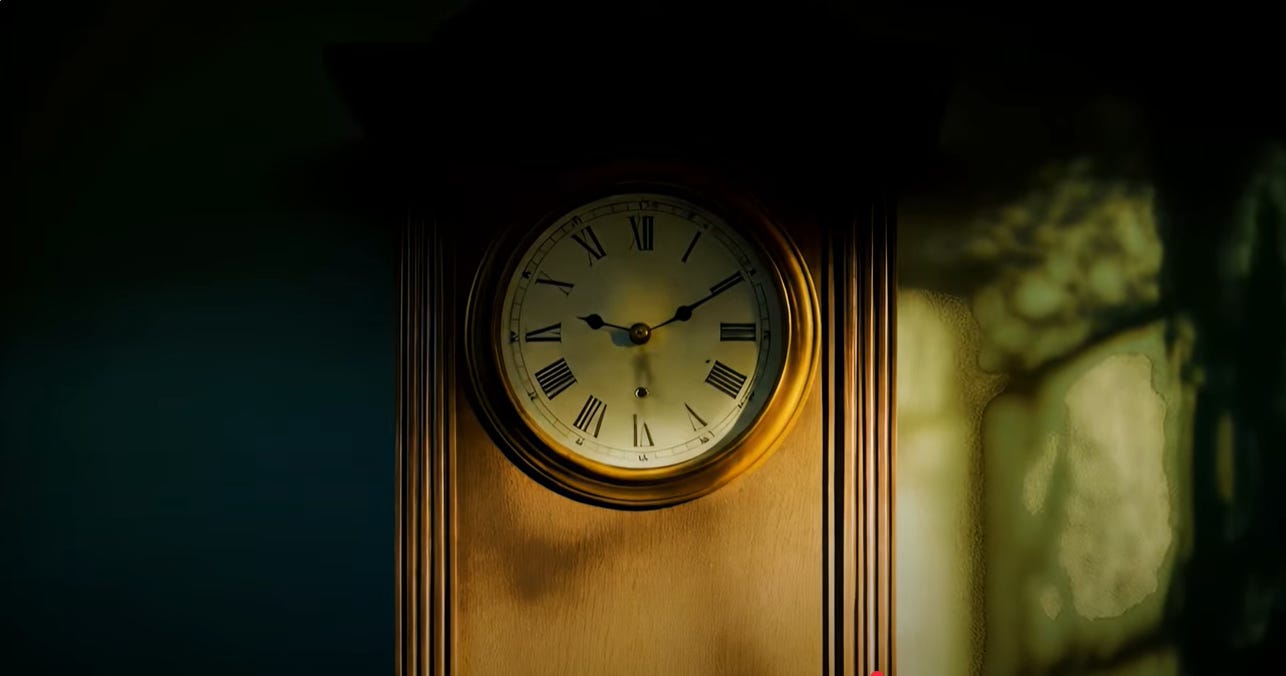In the Age of AI, What Happens When We Stop Believing Anything? Οh, and Dali's AI giraffes
Disinformation and propaganda at the age of GenAI and an AI film that raised eyebrows
Hey future-fit people!
In this second newsletter, I invite you to join me in an exploration of two compelling topics at the intersection of technology, media, and imagination: the growing world of AI-generated propaganda, and an AI-created film that brings to life the dream of a surrealist. Let’s begin with the first.
“If everybody always lies to you, the consequence is not that you believe the lies, but rather that nobody believes anything any longer... And a people that no longer can believe anything cannot make up its mind... With such a people you can do what you please.”
— Hannah Arendt, 1974
This chilling warning from philosopher’s Hannah Arendt last public interview feels eerily timely today. The threat she described—mass disorientation and the erosion of trust—is no longer confined to history. In the age of AI, it’s rapidly becoming our present.
Earlier this year, journalist Nick Bilton wrote in Vanity Fair about a moment that stopped him in his tracks: a viral photo of a huge crowd at a Kamala Harris rally. Trump had claimed the image was AI-generated. Bilton’s first reaction?
He wasn’t skeptical—he was uncertain. He leaned in closer to inspect the image, genuinely wondering if it was real. It turned out the photo was authentic. But that moment of doubt was revealing.
“Once you start living in the land of AI,” Bilton wrote, “your brain starts to question everything—whether you like it or not.”
That cognitive friction—that pause—is a symptom of a deeper issue: a growing inability to trust anything, not even our own perception.

Even if your own mother says she loves you—verify it
Let me be clear: I don’t think skepticism is the enemy. In fact, I believe it’s necessary—especially now. There’s a reason the old journalistic adage goes: “Even if your own mother says she loves you—verify it.”
Fortunately, we’re not powerless. We have incredible fact-checking tools like:
InVID
Google Fact Check Explorer
CaptainFact
Originality.ai
Try them. Use them. Share them. Teach them.
But we also need to guard against something subtler: when skepticism curdles into total mistrust. When that happens, truth itself becomes relative—and that’s when democracies begin to unravel.
ΑΙ-generated propaganda
A few days ago, in the spring-adorned town of Delphi, we had an inspiring conversation with Renee DiResta, author of Invisible Rulers: The People Who Turn Lies into Reality and one of the world’s top experts in online manipulation, disinformation, scams and trolls. Renée has advised Congress, the White House, state legislatures, and business organizations on issues related to technology and policy.
She explained how Generative AI (GenAI) has transformed the nature of propaganda and here’s how I translated her words:
“It’s no longer just governments or state actors. Anyone with access to social media can now produce slick, convincing, emotionally charged propaganda—on demand and at scale.”
Old-school bots once gave themselves away with clumsy slang. But today’s AI? It sounds like you. It mimics nuance, culture, humor—creating a level of plausibility that’s nearly impossible to filter without effort.
Belief, Lies, and Alternate Realities
DiResta also cited one particularly striking example: despite no evidence, over 30% of Americans still believe the 2020 U.S. election was stolen.
Just a few days ago, she added, we saw the re-elected U.S. President issue executive orders targeting people from his previous administration who stated the 2020 election wasn’t stolen. We see this lie being used to target dissenters, and this alternate reality has real political power behind it.
”It’s not just fringe users online spreading it, but one of the most powerful leaders in the world using a lie to exercise political power over a target.”

Curiosity could now save the cat
Is there a way to prepare the next generations of humans to maintain their critical thinking and intelligence in an era when AI may dominate many current human activities? Curiosity to learn more could be a game changer.
“I have three kids—11, 8, and 4 years old—and they’ve seen what GenAI can do because I use it at home for my work as a researcher. I show them what Midjourney can create and we talk about it—about how we think about art today. I tell them we can do the same with text. I explain that we can use AI as a learning tool, but emphasize that these tools are not necessarily reliable.” she says and continues:
“These tools can spark curiosity, be our partners in learning, and participate in our dialogues—but they cannot be the end result of our work or the ultimate source. So for me, the way I’ve chosen to handle it in our family—and the way I see my colleagues handle it—is to teach kids not to fear AI, to see it as a tool, but not to become overly dependent on it. Tell them:
‘You don’t want to turn off your own creativity and critical thinking and rely on something like a crutch. You need to treat it as a tool for the future—but not something that that you should be anchored to.”
She added that multiple forms of literacy are needed in this new era, and one of them is AI literacy—the ability to understand and use AI responsibly.
The genie is out of the bottle -and it’s not getting back in
Is she optimistic that future generations—Gen Alpha (those born between 2010–2012 and 2024–2025) and Gen Beta (those born from now until around 2039)—will preserve their critical thinking and creativity?
“I’m optimistic just because I remember myself—I was in high school when the internet became widely accessible and I could, for the first time, build a website and learn HTML. Realizing that I could not only create something but share it with others was exciting to me. And I see that in my kids too—the realization that if they dream something, they can create it. And I think that’s inspired them to develop new skills to support their dreams. They’re no longer satisfied with the image GenAI produces—which is mediocre; they want to learn to edit images themselves, to improve them. So they’ve developed an interest in digital art more broadly” she said.

My optimism, she added, comes also from the belief that the constructive integration of technology into society has always been what helps us move forward. The genie isn’t going back into the bottle. We’re not going backward. So the question is how we adapt and use it effectively—and how we can mitigate its worst effects. For example, teaching kids: ‘This is how politics works, and this is how propaganda produced by AI works.’ You can really help people see the tricks, so they don’t fall for them again. “It’s like watching a magician with a deck of cards: once you know how the trick is done, the magic doesn’t fool you as easily anymore.”
AI, Truth, and the Battle for Reality
In a recent conversation, Charalambos Tsekeris, chair of Greece’s National Committee on Bioethics and Technoethics, put it this way:
“The ultimate prize is truth itself.”
He warns that powerful actors could use AI to dominate not just markets, but the flow of scientific knowledge, culture, and political discourse—reshaping reality to suit their interests.
We’re already seeing this play out through ideological filter bubbles, epistemic divides, and algorithmically guided infograzing. In this new Cold War of truths, the side with the most convincing story often wins.
But that doesn’t mean the game is lost.
AI Is Profoundly Human
At its core, AI reflects us: our values, our blind spots, our creativity. It’s not magic—it’s a mirror. And the future of that mirror depends on the ethics we embed in it.
As we stand at this historic crossroads, let’s not forget: AI won’t decide the future—we will.
“The world is a very puzzling place,” Noam Chomsky once said.
“If you’re not willing to be puzzled, you just become a replica of someone else’s mind.”
So let’s stay curious. Let’s ask better questions. Let’s resist easy answers—and teach others to do the same.
If this resonated with you, feel free to share, comment, or just hit that heart ❤️. And if you haven’t yet—subscribe below to receive more thoughtful essays straight to your inbox.
🔔 Subscribe and share now — it’s free, and it helps support my work.
Would Dalí Use AI? Absolutely.
A surrealist dream meets algorithmic reality, and not everyone is impressed.
In 1937, Salvador Dalí dreamed up a film too strange to be made—at least for that era. Giraffes on Horseback Salad, a cinematic fever dream envisioned for the Marx Brothers, was shelved before it could ever become reality. Groucho Marx thought it wasn’t funny, and even in the surrealist heyday, it was deemed too bizarre to shoot with the technology of the time.
Fast forward nearly a century.
In 2025, Dalí’s unfinished vision is finally being brought to life—not by artists in berets or directors with megaphones, but by algorithms. The project is now powered by Google’s generative AI filmmaking tools, with the official stamp of approval from the Dalí Museum in Florida. The trailer is already out in the wild.
And it’s… not exactly winning hearts.
Ethics and aesthetics
Art critic Ben Davis didn’t mince words in his review on Artnet, calling the project “bad.” The film is the work of Goodby, Silverstein & Partners—a San Francisco ad agency known more for their campaigns with Cheetos than their deep dives into surrealism.
Davis takes issue not just with the aesthetics, but the ethics. He writes:
“When Google says the film shows how ‘customers are delivering value with generative media models,’ they seemingly mean how it allows marketers to strip-mine beloved IP without having to work with someone who cares about it.”
He also notes that the film strays far from Dalí’s original vision. The “Surrealist Woman” that Dalí imagined—his muse Gala, whose face was never to be seen—is now shown in full close-up. And her ear? Missing an opening. Make of that what you will.
AI and the Democratization of Art
I’m not here to critique the trailer’s artistic merit. I’m not an art critic. But I do have a deep belief in the creative power of AI.
Generative AI can elevate art to places we’ve never reached before. It democratizes creation, opening the doors for people without access to traditional tools, funding, or training. That’s powerful.
Of course, there’s a valid concern that we’re heading toward a world of homogeneity, where originality flattens under the weight of algorithmic averages. We’re feeding large language and image models with existing data, after all—so how much truly new art can they make?
But as always, the difference will lie in the artist’s touch. Everyone can pick up a paintbrush. Few can paint. And fewer still can create something that stops you cold—makes your mind spark and your heart race (or slow, depending).
Dalí and His Love Affair with Science
Let’s not forget: Dalí had an intense fascination with science and technology. He once said he enjoyed “swimming between the cold waters of art and the warm waters of science.” He wasn’t interested in pitting them against each other—he wanted synthesis. Harmony.
Later in life, he became enthralled with quantum physics, subatomic particles, and even the digital nature of matter itself. He saw no conflict between surrealism and scientific exploration—just opportunity.
Even George Orwell, in his 1944 essay Benefit of Clergy, called Dalí a “disgusting human being” but acknowledged his undeniable genius. And that genius, I’m convinced, would be tinkering with generative AI today.
But the Trailer…?
It doesn’t thrill me. Not because it uses AI—but because it doesn’t feel like Dalí.
Take the clocks. In The Persistence of Memory, Dalí’s melting clocks symbolize the fluidity of time, especially in dreams where past, present, and future lose meaning. In this trailer, the only clock we see doesn’t do that. The surrealism seems reduced to a jumble of Latin numerals and cheap visuals. It lacks depth, intention—Dalí’s soul.
There are moments that feel rushed, careless. But I’ll say this again:
Dalí would have used AI
Not to mimic the past, but to shatter it into glittering shards and rearrange them into something profoundly new.
And maybe that’s the real challenge for us now: not just to use the tools, but to use them with vision.
Thanks for reading. If you enjoyed this piece, subscribe for more thoughts on creativity, tech, and the strange new intersections in between.





